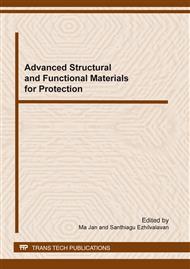[1]
R.M. German, Powder Injection Molding, Metal Powder Industries Federation, Princeton, N. J, (1990).
Google Scholar
[2]
R.M. German and A. Bose, Powder Injection Molding of Metal and Ceramics, Metal Powder Industries Federation, Princeton, N. J, (1997).
Google Scholar
[3]
R.M. German, Powders, binders and feed stocks for powder injection molding, Powder Injection Moulding International, Vol 1 no. 1, 2007, pp.34-39.
Google Scholar
[4]
M.T. Zaky , F.S. Soliman, S. Farag, Influence of Parafiin Wax characteristics on the formulation of wax based binder and their debinding from green molded parts using two comparative techniques, J. Material Processing Technology, 209, 2009, pp.5981-89.
DOI: 10.1016/j.jmatprotec.2009.07.018
Google Scholar
[5]
Ming-Shyan Huang and Hung-Chuan Hsu, Effect of backbone polymer on properties of 316L stainless steel MIM compact , J. Mat. Processing Tech., Vol 209, Issues 15-16, 2009, pp.5527-5535.
DOI: 10.1016/j.jmatprotec.2009.05.011
Google Scholar
[6]
A. Nylund, T. Tunberg, H. Bertilsson, E. Carlstrom and I. Olefjord, Int. J. Powder Metall. 31, 1995, (4), p.365–373.
Google Scholar
[7]
N.H. Loh, S. B. Tor and K. A. Khor , Production of metal matrix composite part by powder injection molding ,J. Mat Processing Technology, vol 108, 2001, pp.398-407.
DOI: 10.1016/s0924-0136(00)00855-4
Google Scholar
[8]
R.M. German and M. Bulgeeim, The effects of bimodal injection molded compacts, Solid State Phenomena, 1992b, 25-26: 55-62.
DOI: 10.4028/www.scientific.net/ssp.25-26.55
Google Scholar
[9]
A. Bose, I. Otsuka, T. Yoshida, H. Toyoshima, Faster sintering and lower costs with ultra fine mim powders. Metal Powder Report. 2008, 63, 5, 25-30.
DOI: 10.1016/s0026-0657(08)70058-4
Google Scholar
[10]
Tae Shik YOON, You Hwan LEE, Sang Ho AHN, Jung Hwan LEE and Chong Soo LEE, Effects of Sintering Conditions on the Mechanical Properties of Metal Injection Molded 316L Stainless Steel, , ISIJ International, 2003, 43, 1, 119–126.
DOI: 10.2355/isijinternational.43.119
Google Scholar
[11]
B. S Decker, J.D. Bolton, A.M. Eagles, Sintering of 316L stainless steel to high density via the addition of Chromium – molybdenum dibromide powders, Part1: Sintering performance and mechanical properties, Proc Instn Mech Engrs, Vol 214 Part L, (2000).
DOI: 10.1243/1464420001544753
Google Scholar
[12]
C.R. Brooks, Materallurgical Failure Analysis, McGraw Hill (1993).
Google Scholar


